The Seaport Security Management Market is estimated to be valued at USD 5.8 billion in 2025 and is projected to reach USD 12.0 billion by 2035, registering a compound annual growth rate (CAGR) of 7.5% over the forecast period.
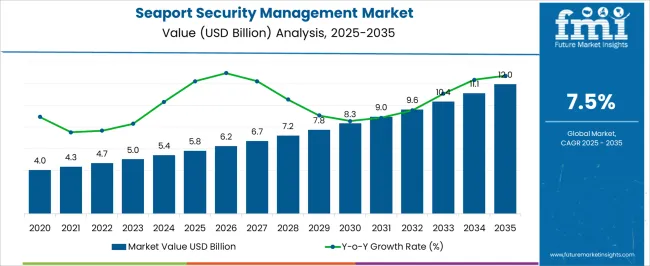
| Metric | Value |
|---|---|
| Seaport Security Management Market Estimated Value in (2025 E) | USD 5.8 billion |
| Seaport Security Management Market Forecast Value in (2035 F) | USD 12.0 billion |
| Forecast CAGR (2025 to 2035) | 7.5% |
The Seaport Security Management market is witnessing steady expansion as global trade volumes and maritime infrastructure investments continue to rise. The current environment is being shaped by increasing concerns regarding unauthorized access, cargo theft, smuggling, and cybersecurity threats across critical port facilities. Growing reliance on automated surveillance systems and integrated security frameworks is enhancing the operational efficiency and safety of seaports.
With advancements in artificial intelligence, data analytics, and IoT-enabled devices, security solutions are being tailored to provide real-time monitoring and rapid threat assessment. Investment in infrastructure modernization and regulatory requirements to strengthen maritime safety are contributing to the demand for advanced security services. The integration of surveillance and reconnaissance systems with broader port management solutions is being seen as essential to address emerging challenges.
The market’s future outlook is expected to be further supported by rising collaboration between port authorities, logistics operators, and government agencies, aiming to safeguard assets while streamlining operations As global shipping networks continue to grow, opportunities for advanced security services and systems integration are anticipated to expand.
The seaport security management market is segmented by service, application, and geographic regions. By service, seaport security management market is divided into System Integration, Facility and Asset Management, and Training and Consulting.
In terms of application, seaport security management market is classified into Surveillance & Reconnaissance, Communication, Computers, and Others. Regionally, the seaport security management industry is classified into North America, Latin America, Western Europe, Eastern Europe, Balkan & Baltic Countries, Russia & Belarus, Central Asia, East Asia, South Asia & Pacific, and the Middle East & Africa.
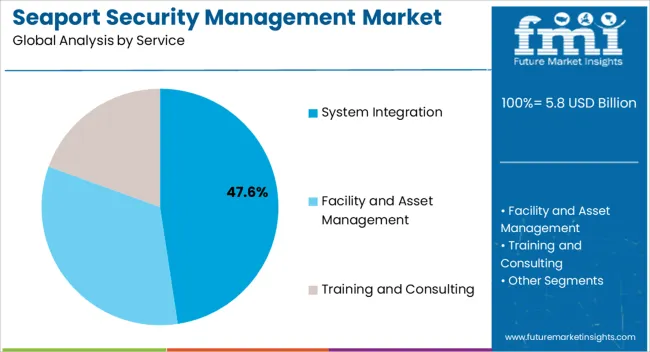
The system integration service segment is projected to hold 47.60% of the Seaport Security Management market revenue share in 2025, establishing it as the leading service offering. This segment’s growth is being attributed to the increasing need for cohesive security frameworks that combine multiple technologies into unified platforms. The ability to integrate surveillance tools, access controls, and communication networks has allowed port authorities to implement comprehensive security strategies without managing fragmented systems.
Enhanced situational awareness, faster threat detection, and centralized control capabilities have made integrated systems essential in safeguarding cargo, personnel, and infrastructure. The rising complexity of port operations and the requirement to meet strict regulatory standards have further accelerated the adoption of integration services.
These services are also being favored for their capacity to support scalable deployments and enable upgrades without overhauling existing infrastructure With growing concerns regarding physical and digital security risks, system integration services are being increasingly relied upon to offer seamless coordination across diverse security applications.
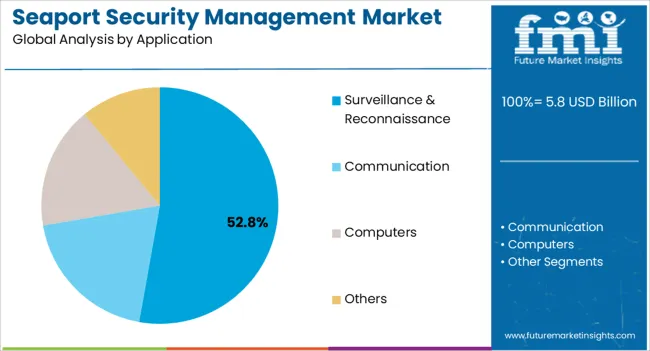
The surveillance and reconnaissance application segment is expected to account for 52.80% of the total Seaport Security Management market revenue share in 2025, making it the largest application category. The expansion of this segment is being driven by the heightened need for real-time monitoring and threat detection at seaports handling large volumes of cargo and passenger traffic. Surveillance systems are being deployed to ensure continuous monitoring of vessel movements, restricted zones, and access points, while reconnaissance tools provide early warnings for potential breaches or hazards.
The integration of high-resolution imaging, sensor networks, and data analytics has significantly improved detection accuracy, helping port authorities respond quickly to emerging threats. Growing investments in maritime security infrastructure and adherence to international safety protocols are also contributing to the segment’s prominence.
Additionally, the increasing adoption of automated systems and remote monitoring solutions has made surveillance and reconnaissance applications indispensable for protecting assets and maintaining compliance As ports seek to enhance operational resilience, this segment’s growth is being supported by demand for reliable, scalable, and intelligent monitoring solutions.
With the increase in logistical supplements from other countries and terrorism activities near seaports, the seaport security management has adopted. Nowadays, marine routes are the best means of transportation and travelling.
Every day, thousands of containers arrive at seaports from countries all around the world, which also increases threats of terrorism. Seaport security management helps in providing security, which addresses the legislative measures, regulatory issues, and logistical aspects of port security.
Seaport security management play a very important role by enabling long range connectivity, not only between ships and coast guards of different nations. Nowadays, the seaport security management is adopted by many seaport managements of several countries, which provides better protection, surveillance, safety and control.
Seaport security management is important in many ways, such as it enables increased levels of safety of citizens and efficiency for mariners throughout the world.
Seaport security management is also coupled with geographic information system (GIS) and SONAR technologies to provide the efficient management and operation of automated container placement for security purposes.
The increasing growth seaport security management market is due to the growing terrorism threats and regional conflicts among the various countries is expected to fuel the global seaport security management market growth.
The seaport security management system is also used as a transmitting and receiving interference between ships and coast guards to track vessels.
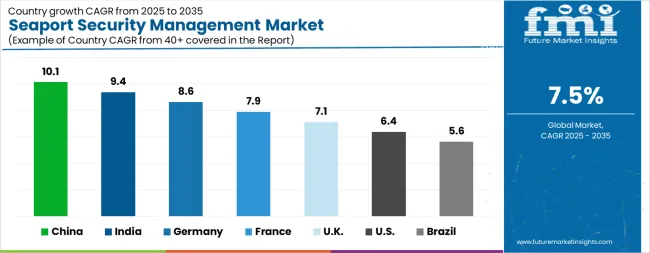
| Country | CAGR |
|---|---|
| China | 10.1% |
| India | 9.4% |
| Germany | 8.6% |
| France | 7.9% |
| UK | 7.1% |
| USA | 6.4% |
| Brazil | 5.6% |
The Seaport Security Management Market is expected to register a CAGR of 7.5% during the forecast period, exhibiting varied country level momentum. China leads with the highest CAGR of 10.1%, followed by India at 9.4%. Developed markets such as Germany, France, and the UK continue to expand steadily, while the USA is likely to grow at consistent rates.
Brazil posts the lowest CAGR at 5.6%, yet still underscores a broadly positive trajectory for the global Seaport Security Management Market. In 2024, Germany held a dominant revenue in the Western Europe market and is expected to grow with a CAGR of 8.6%.
The USA Seaport Security Management Market is estimated to be valued at USD 2.0 billion in 2025 and is anticipated to reach a valuation of USD 3.8 billion by 2035. Sales are projected to rise at a CAGR of 6.4% over the forecast period between 2025 and 2035. While Japan and South Korea markets are estimated to be valued at USD 266.9 million and USD 201.7 million respectively in 2025.
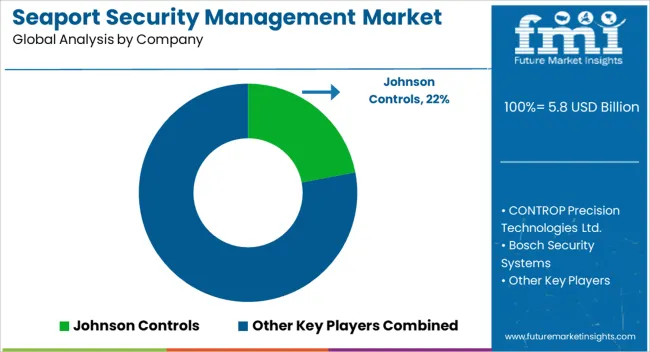
| Item | Value |
|---|---|
| Quantitative Units | USD 5.8 Billion |
| Service | System Integration, Facility and Asset Management, and Training and Consulting |
| Application | Surveillance & Reconnaissance, Communication, Computers, and Others |
| Regions Covered | North America, Europe, Asia-Pacific, Latin America, Middle East & Africa |
| Country Covered | United States, Canada, Germany, France, United Kingdom, China, Japan, India, Brazil, South Africa |
| Key Companies Profiled | Johnson Controls, CONTROP Precision Technologies Ltd., Bosch Security Systems, Unisys, CNL Software, FLIR Systems, Honeywell International, Saab AB, Siemens, L3Harris Technologies, and Raytheon |
The global seaport security management market is estimated to be valued at USD 5.8 billion in 2025.
The market size for the seaport security management market is projected to reach USD 12.0 billion by 2035.
The seaport security management market is expected to grow at a 7.5% CAGR between 2025 and 2035.
The key product types in seaport security management market are system integration, facility and asset management and training and consulting.
In terms of application, surveillance & reconnaissance segment to command 52.8% share in the seaport security management market in 2025.






Our Research Products

The "Full Research Suite" delivers actionable market intel, deep dives on markets or technologies, so clients act faster, cut risk, and unlock growth.

The Leaderboard benchmarks and ranks top vendors, classifying them as Established Leaders, Leading Challengers, or Disruptors & Challengers.

Locates where complements amplify value and substitutes erode it, forecasting net impact by horizon

We deliver granular, decision-grade intel: market sizing, 5-year forecasts, pricing, adoption, usage, revenue, and operational KPIs—plus competitor tracking, regulation, and value chains—across 60 countries broadly.

Spot the shifts before they hit your P&L. We track inflection points, adoption curves, pricing moves, and ecosystem plays to show where demand is heading, why it is changing, and what to do next across high-growth markets and disruptive tech

Real-time reads of user behavior. We track shifting priorities, perceptions of today’s and next-gen services, and provider experience, then pace how fast tech moves from trial to adoption, blending buyer, consumer, and channel inputs with social signals (#WhySwitch, #UX).

Partner with our analyst team to build a custom report designed around your business priorities. From analysing market trends to assessing competitors or crafting bespoke datasets, we tailor insights to your needs.
Supplier Intelligence
Discovery & Profiling
Capacity & Footprint
Performance & Risk
Compliance & Governance
Commercial Readiness
Who Supplies Whom
Scorecards & Shortlists
Playbooks & Docs
Category Intelligence
Definition & Scope
Demand & Use Cases
Cost Drivers
Market Structure
Supply Chain Map
Trade & Policy
Operating Norms
Deliverables
Buyer Intelligence
Account Basics
Spend & Scope
Procurement Model
Vendor Requirements
Terms & Policies
Entry Strategy
Pain Points & Triggers
Outputs
Pricing Analysis
Benchmarks
Trends
Should-Cost
Indexation
Landed Cost
Commercial Terms
Deliverables
Brand Analysis
Positioning & Value Prop
Share & Presence
Customer Evidence
Go-to-Market
Digital & Reputation
Compliance & Trust
KPIs & Gaps
Outputs
Full Research Suite comprises of:
Market outlook & trends analysis
Interviews & case studies
Strategic recommendations
Vendor profiles & capabilities analysis
5-year forecasts
8 regions and 60+ country-level data splits
Market segment data splits
12 months of continuous data updates
DELIVERED AS:
PDF EXCEL ONLINE
Data Security Posture Management (DSPM) Solutions Market Size and Share Forecast Outlook 2025 to 2035
Security and Vulnerability Management Market Forecast and Outlook 2025 to 2035
Security Information and Event Management Software Market
Network Security Policy Management Market Size and Share Forecast Outlook 2025 to 2035
Mobile Threat Management Security Software Market Size and Share Forecast Outlook 2025 to 2035
Physical Security Information Management (PSIM) Market Size and Share Forecast Outlook 2025 to 2035
Security Tape Market Size and Share Forecast Outlook 2025 to 2035
Security Alarm Communicator Market Size and Share Forecast Outlook 2025 to 2035
Security Holograms Market Size and Share Forecast Outlook 2025 to 2035
Security Paper Market Size and Share Forecast Outlook 2025 to 2035
Security System Tester Market Size and Share Forecast Outlook 2025 to 2035
Security Advisory Services Market Size and Share Forecast Outlook 2025 to 2035
Security Room Control Market Size and Share Forecast Outlook 2025 to 2035
Security Cameras (IR Illuminator) Market Size and Share Forecast Outlook 2025 to 2035
Security Operation Centre as a Service Market Size and Share Forecast Outlook 2025 to 2035
Security Robots Market Size and Share Forecast Outlook 2025 to 2035
Security Service Edge Market Size and Share Forecast Outlook 2025 to 2035
Security and Surveillance Equipment Market Size and Share Forecast Outlook 2025 to 2035
Security Orchestration Automation and Response (SOAR) Market Size and Share Forecast Outlook 2025 to 2035
Security Bags Market Size and Share Forecast Outlook 2025 to 2035

Thank you!
You will receive an email from our Business Development Manager. Please be sure to check your SPAM/JUNK folder too.
Chat With
MaRIA